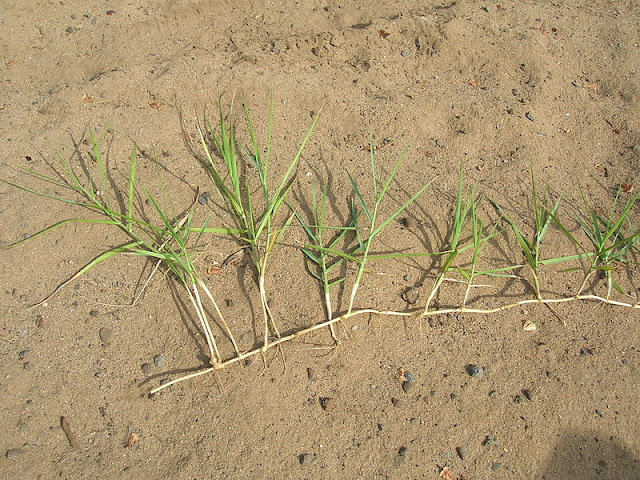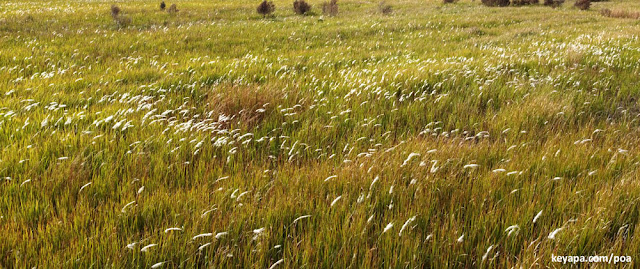Amazingly, some types of grasses (and other plants) that are clonal and spread laterally via rhizomes or stolons display behaviors that are just as fascinating and almost analogous to that seen in these social insects. Grasses that spread through the use of horizontal stems (called rhizomes if the stem is underground, and stolons if the stem if aboveground) produce genetically identical clones that are each called "ramets". These ramets are fully developed plants, and will function as complete individuals when separated from the rest of the group if the rhizome or stolon is severed. The entire cluster of genetically identical ramets is called a "genet".
 |
| Connected Panicum repens ramets by Forest & Kim Starr, Plants of Hawaii, Image 050902-4373, from Wikipedia |
Researchers have found that clusters of interconnected ramets have attributes that cannot be found in non-clonal species. Not only does information flow between the members of the genet, but nutrients and water can be translocated throughout the entire network of ramets. This ability to actively and deliberately move information and other materials is called "clonal integration", and it allows these clonal grasses to withstand stresses in heterogeneous environments that separated individual plants cannot.
As an example, think of a location where one area is partly shaded, but one is sunlit. Since plants cannot move to shift their location, individuals who end up in the less sunlit part will not grow as well. However, a clonal grass with ramets spread across both light gradients will be able to overcome this problem. Remarkably, ramets in the well lit environment will translocate photosynthate to the less fortunate members of the cluster, and studies have shown this does not negatively impact their own growth. In the same way, ramets in soil with rich amounts of needed minerals or water will move any necessary nutrients to other ramets that are located in less favorable locations. So it actually might be possible to have a situation where a ramet in a well lit but nutrient poor area is both sending photosynthate and simultaneously receiving minerals from a ramet which is in a dimly lit but nutrient rich soil nearby!
 |
| Image showing movement of materials across ramets (via rhizomes/stolons) in heterogeneous environment |
Another behavior of clonal grasses which is similar to social insects is foraging. In this case, the genet "forages" in space as it produces new ramets around it. When it encounters an area that is optimal (for example, it is well lit), it concentrates the production of new ramets in that location, usually by decreasing the internode length of its rhizomes or stolons so the density of ramets increases. The newly developed ramets can then help support the rest of the genet by translocating photosynthate and nutrients to the cluster.
These range of behaviors displayed by clonal grasses and other plants is absolutely fascinating to me because I am also an observer of social insects. It reinforces the idea of plants as active participants in the landscape, albeit at a different time scale than short lived animals, and I hope to keep up with research on clonal integration in the future.

2 comments:
Very interesting. Does this make these species even better for rehabilation purposes? Thanks for sharing. Love it.
I think if you are going to use specific species then check first to make sure that they are not invasive, as some clonal species are invasive. But yes, I would think clonal species that proliferate quickly and are buffered from differences in the area being treated are good for such purposes.
Post a Comment